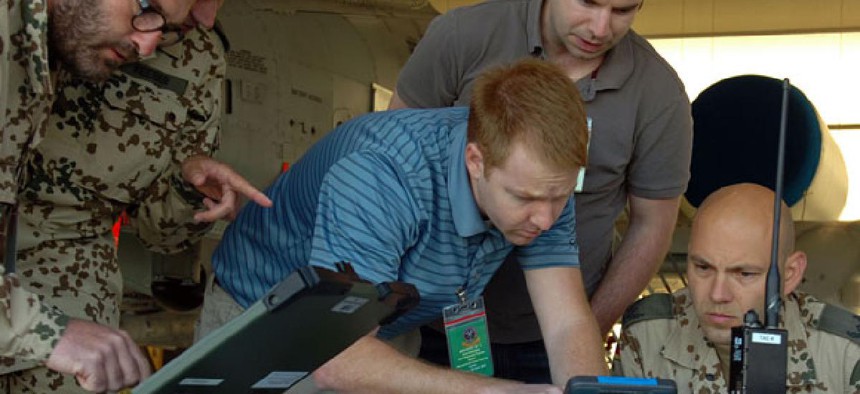Joint Staff will develop a digital close air support system

Coalition forces assess Digitally Aided Close Air Support technologies in June. Defense Department
The new technology will aid multinational operations.
NORFOLK, VA. -- Despite the digital revolution, ground forward air controllers continue to call in and manage air strikes the same way they did during the Vietnam War more than 50 years ago -- by talking to pilots over voice radios.
The Command and Control Integration branch of the Joint Staff Directorate for Command, Control, Communications and Computers, known as the J6, wants to change that with a digitally aided close air support system that can be used by all four services, as well as by partner nations over myriad radio systems and multiple aircraft.
Mike “Axel” Foley, a program analyst with the C2 Integration Joint Fires Division, said the confusion that can result from using voice communications in multinational operations illustrates the need for switching to digital messaging for close air support management.
Close air support uses a standard nine line message format that defines key parameters, including target location, elevation, location of friendly forces, aircraft heading to target and the exit heading from the target.
Foley said transmitting such information by voice in combat is difficult enough when the ground controller and pilot are both Americans, but when a French air controller tries to communicate with an American A-10 pilot who has an Alabama accent, the exchange becomes even more daunting.
Garbled voice communications also can result in fratricide, as retired Air Force Chief Master Sgt. Mickey Wright pointed out in an article in the Air Commando Journal this February citing an incident when a B-52 bombed U.S. special forces troops in Afghanistan. Wright, who retired after 30 years as a combat controller, said the Defense Department needs to embrace technology to reduce such incidents.
Ryan Schultz, chief of the C2 data standards branch, said digital close air support systems use an Internet standard -- XML -- to bring order to voice babble, which allows for the exchange of comprehensible digital messages for systems on the ground and those installed in a variety of aircraft. It also can be leveraged by multinational partners.
Marsha Mullis, a systems engineer with the C2 division, said the data system also ties in information derived from laser designators used by ground controllers to pinpoint a target and then passes that information digitally to an aircraft.
Foley said the digital close air support system underwent an extensive workout during the Bold Quest 12-1 exercise at Camp Atterbury in Indiana in June. There, 30 joint terminal attack controllers from seven nations used the system to control multiple aircraft, an exercise that put the system through its paces in a real-world scenario.
The C2 division continues to tweak and develop the digital close air support system and also is beefing it up to support other weapons, including naval gunfire and artillery, Foley said.
Mullins said the full-scale development and deployment of the digital close air support system is not a technology problem, but a standards and policy issue that will require a buy-in from all four services.






